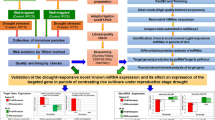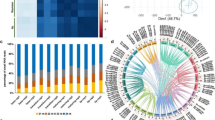Abstract
microRNAs are a class of ∼21-nt long, non-coding and newly-identified RNAs that play critical roles in post-transcriptional gene regulation. Their targets are involved in various biological processes, including development, metabolism, and stress response. Though a large number of miRNAs have been reported in many species, reports of miRNAs in sorghum are limited. Using a homology search based on the genomic survey sequence (GSS) and the microRNA (miRNA) secondary structure, a total of 17 new miRNAs were identified in this work. They were found to be distributed unevenly among 11 miRNA families. Some miRNA genes were found at multiple locations and in more than one genomic context. Most miRNAs are conserved within the same kingdom, but we found in sorghum that sbi-miR127 and sbi-miR466 showed conservation with H. sapiens and M. musculus, respectively. Analysis of those 17 new miRNAs via online software miRU showed that they might regulate 64 target genes, most of which are involved in RNA processing, metabolism, cell cycle, protein degradation, stress response and transportation. At least 7 of 11 miRNA families target proteins that are necessary in metabolism and stress response, including NADPH-cytochrome P450 reductase, nucleoside diphosphate kinase and superoxide dismutase, suggesting that miRNAs play an essential role in biological processes.
Similar content being viewed by others
References
Hattori T, Sonobe K, Araki H, et al. Silicon application by sorghum through the alleviation of stress-induced increase in hydraulic resistance. J Plant Nutr, 2008, 31: 1482–1495
Prasad P V V, Pisipati S R, Mutava R N, et al. Sensitivity of grain sorghum to high temperature stress during reproductive development. Crop Sci, 2008, 48: 1911–1917
Bartel D P. microRNAs: Genomics, biogenesis, mechanism, and function. Cell, 2007, 131: 11–29
Hunter C, Poethig R S. Missing links: miRNAs and plant development. Curr Opin Genet Dev, 2003, 13: 372–378
Ke X S, Liu C M, Liu D P, et al. MicroRNAs: Key participants in gene regulatory networks-Commentary. Curr Opin Chem Biol, 2003, 7: 516–523
Kidner C A, Martienssen R A. Macro effects of microRNAs in plants. Trends Genet, 2003, 19: 13–16
Murchison E P, Hannon G J. MiRNAs on the move: miRNA biogenesis and the RNAi machinery. Curr Opin Cell Biol, 2004, 16: 223–229
Lee R C, Feinbaum R L, Ambros V. The C. telegans heterochronic gene lin-4 encodes small RNAs with antisense complementarity to lin-14. Cell, 1993, 75: 843–854
Lagos-Quintana M, Rauhut R, Lendeckel W, et al. Identification of novel genes coding for small expressed RNAs. Science, 2001, 294: 853–858
Lau N C, Lim L P, Weinstein E G, et al. An abundant class of tiny RNAs with probable regulatory roles in Caenorhabditis elegans. Science, 2001, 294: 858–862
Khvorova A, Reynolds A, Jayasena S D. Functional siRNAs and miRNAs exhibit strand bias. Cell, 2007, 131: 41–49
Hake S. MicroRNAs: A role in plant development. Curr Biol, 2003, 13: R851–R852
Valencia-Sanchez M A, Liu J D, Hannon G J, et al. Control of translation and mRNA degradation by miRNAs and siRNAs. Gene Dev, 2006, 20: 515–524
Doench J G, Petersen C P, Sharp P A. siRNAs can function as miRNAs. Gene Dev, 2003, 17: 438–442
Zeng Y, Yi R, Cullen B R. microRNAs and small interfering RNAs can inhibit mRNA expression by similar mechanisms. Proc Natl Acad Sci USA, 2003, 100: 9779–9784
Wightman B, Ha I, Ruvkun G. Post transcriptional regulation of the heterochronic gene lin-14 by lin-4 mediates temporal pattern-formation in C. elegans. Cell, 1993, 75: 855–862
Olsen P H, Ambros V. The lin-4 regulatory RNA controls developmental timing in Caenorhabditis elegans by blocking LIN-14 protein synthesis after the initiation of translation. Dev Biol, 1999, 216: 671–680
Seggerson K, Tang L J, Moss E G. Two genetic circuits repress the Caenorhabditis elegans heterochronic gene lin-28 after translation initiation. Dev Biol, 2002, 243: 215–225
Moss E G, Lee R C, Ambros V. The cold shock domain protein LIN-28 controls developmental timing in C. elegans and is regulated by the lin-4 RNA. Cell, 1997, 88: 637–646
Llave C, Kasschau K D, Rector M A, et al. Endogenous and silencing-associated small RNAs in plants. Plant Cell, 2002, 14: 1605–1619
Park W, Li J, Song R, et al. CARPEL factory, a Dicer homolog, and HEN1, a novel protein, act in microRNA metabolism in Arabidopsis thaliana. Curr Biol, 2002, 12: 1484–1495
Palatnik J F, Allen E, Wu X, et al. Control of leaf morphogenesis by microRNAs. Nature, 2003, 425: 257–263
Rhoades M W, Reinhart B J, Lim L P, et al. Prediction of plant microRNA targets. Cell, 2002, 110: 513–520
Tay Y, Zhang J Q, Thomson A M, et al. microRNAs to Nanog, Oct4 and Sox2 coding regions modulate embryonic stem cell differentiation. Nature, 2008, 455: 1124–1128
Grad Y, Aach J, Hayes G D, et al. Computational and experimental identification of C. elegans microRNAs. Mol Cell, 2003, 11: 1253–1263
Lee R C, Ambros V. An extensive class of small RNAs in Caenorhabditis elegans. Science, 2001, 294: 862–864
Mourelatos Z, Dostie J, Paushkin S, et al. MiRNPs: A novel class of ribonucleoproteins containing numerous microRNAs. Gene Dev, 2002, 16: 720–728
Reinhart B J, Weinstein E G, Rhoades M W, et al. microRNAs in plants. Gene Dev, 2002, 16: 1616–1626
Yoon S, Micheli G D. Computational identification of microRNAs and their targets. Birth Defects Res, 2006, 78: 118–128
Wang X J, Reyes J L, Chua N H, et al. Prediction and identification of Arabidopsis thaliana microRNAs and their mRNA targets. Genome Biol, 2004, 5: R65
Adai A, Johnson C, Mlotshwa S, et al. Computational prediction of miRNAs in Arabidopsis thaliana. Genome Res, 2005, 15: 78–91
Jones-Rhoades M W, Bartel D P. Computational identification of plant microRNAs and their targets, including a stress-induced miRNA. Mol Cell, 2004, 14: 787–799
Zhang B H, Pan X P, Wang Q L, et al. Identification and characterization of new plant microRNAs using EST analysis. Cell Res, 2005, 15: 336–360
Zhang B H, Wang Q, Wang K, et al. Identification of cotton microRNAs and their targets. Gene, 2007, 397: 26–37
Lai E C, Tomancak P, Williams R W, et al. Computational identification of Drosophila microRNA genes. Genome Biol, 2003, 4:R42
Rajewsky N, Socci N D. Computational identification of microRNA targets. Dev Biol, 2004, 267: 529–535
Altschul S F, Gish W, Miller W, et al. Basic local alignment search tool. J Mol Biol, 1990, 215: 403–410
Dezulian T, Remmert M, Palatnik J F, et al. Identification of plant microRNA homologs. Bioinformatics, 2006, 22: 359–360
Sunkar R, Jagadeeswaran G. In silico identification of conserved microRNAs in large number of diverse plant species. BMC Plant Biol, 2008, 8: 37
Zhang B, Pan X, Cannon C H, et al. Conservation and divergence of plant microRNA genes. Plant J, 2006, 46: 243–259
Zhang Y. Mi RU: An automated plant miRNA target prediction server. Nucleic Acids Res, 2005, 33(Web Server issue): W701–W704
Giegerich R, Voss B, Rehmsmeier M. Abstract shapes of RNA. Nucleic Acids Res, 2004, 32: 4843–4851
Reeder J, Giegerich R. Consensus shapes: An alternative to the Sankoff algorithm for RNA consensus structure prediction. Bioinformatics, 2005, 21: 3516–3523
Steffen P, Voss B, Rehmsmeier M, et al. RNAshapes: An integrated RNA analysis package based on abstract shapes. Bioinformatics, 2006, 22: 500–503
Zhang B H, Pan X P, Cox S B, et al. Evidence that miRNAs are different from other RNAs. Cell Mol Life Sci, 2006, 63: 246–254
Grun D, Wang Y L, Langenberger D, et al. microRNA target predictions across seven Drosophila species and comparison to mammalian targets. PLoS Comput Biol, 2005, 1: e13
Kurima K, Peters L M, Yang Y, et al. Dominant and recessive deafness caused by mutations of a novel gene, TMC1, required for cochlear hair-cell function. Nat Genet, 2002, 30: 277–284
Li D M, Sun H. TEP1, encoded by a candidate tumor suppressor locus, is a novel protein tyrosine phosphatase regulated by transforming growth factor beta. Cancer Res, 1997, 57: 2124–2129
Popea R K, Pestonjamaspa K N, Smithb K P, et al. Cloning, characterization, and chromosomal localization of human supervillin (SVIL). Genomics, 1998, 52: 342–351
Carrington J C, Ambros V. Role of microRNAs in plant and animal development. Science, 2003, 301: 336–338
Zhang B H, Pan X P, Anderson T A. microRNA: A new player in stem cells. J Cell Physiol, 2006, 209: 266–269
Zhang B H, Pan X P, Anderson T A. Identification of 188 conserved maize micro RNAs and their targets. FEBS Lett, 2006, 580: 3753–3762
Zhang BH, Pan X, Cobb G P, et al. Plant microRNA: A small regulatory molecule with big impact. Dev Biol, 2006, 289: 3–16
Shephard E A, Palmer C N, Segall H J, et al. Quantification of cytochrome-P450 reductase gene-expression in human tissues. Arch Biochem Biophys, 1992, 294: 168–172
Hubbard P A, Shen A L, Paschke R, et al. NADPH-cytochrome P450 oxidoreductase — Structural basis for hydride and electron transfer. J Biol Chem, 2001, 276: 29163–29170
Sampedro J, Sieiro C, Revilla G, et al. Cloning and expression pattern of a gene encoding an alpha-xylosidase active against xyloglucan oligosaccharides from Arabidopsis. Plant Physiol, 2001, 126: 910–920
Federspiel N A, Palm C J, Conway A B, et al. Submitted to the EMBL/GenBank/DDBJ databases, 1999
Yoshida R, Hobo T, Ichimura K, et al. ABA-activated SnRK2 protein kinase is required for dehydration stress signaling in Arabidopsis. Plant Cell Physiol, 2002, 43: 1473–1483
Hrabak E M, Chan C W, Gribskov M, et al. The Arabidopsis CDPK-SnRK superfamily of protein kinases. Plant Physiol, 2003, 132: 666–680
Mustilli A C, Merlot S, Vavasseur A, et al. Arabidopsis OST1 protein kinase mediates the regulation of stomatal aperture by abscisic acid and acts upstream of reactive oxygen species production. Plant Cell, 2002, 14: 3089–3099
Rochester D E, Winer J A, Shah D M. The structure and expression of maize genes encoding the major heat-shock protein, HSP70. EMBO J, 1986, 5: 451–458
Author information
Authors and Affiliations
Corresponding author
Additional information
These authors contributed equally to this work
About this article
Cite this article
Du, J., Wu, Y., Fang, X. et al. Prediction of sorghum miRNAs and their targets with computational methods. Chin. Sci. Bull. 55, 1263–1270 (2010). https://doi.org/10.1007/s11434-010-0035-4
Received:
Accepted:
Published:
Issue Date:
DOI: https://doi.org/10.1007/s11434-010-0035-4




